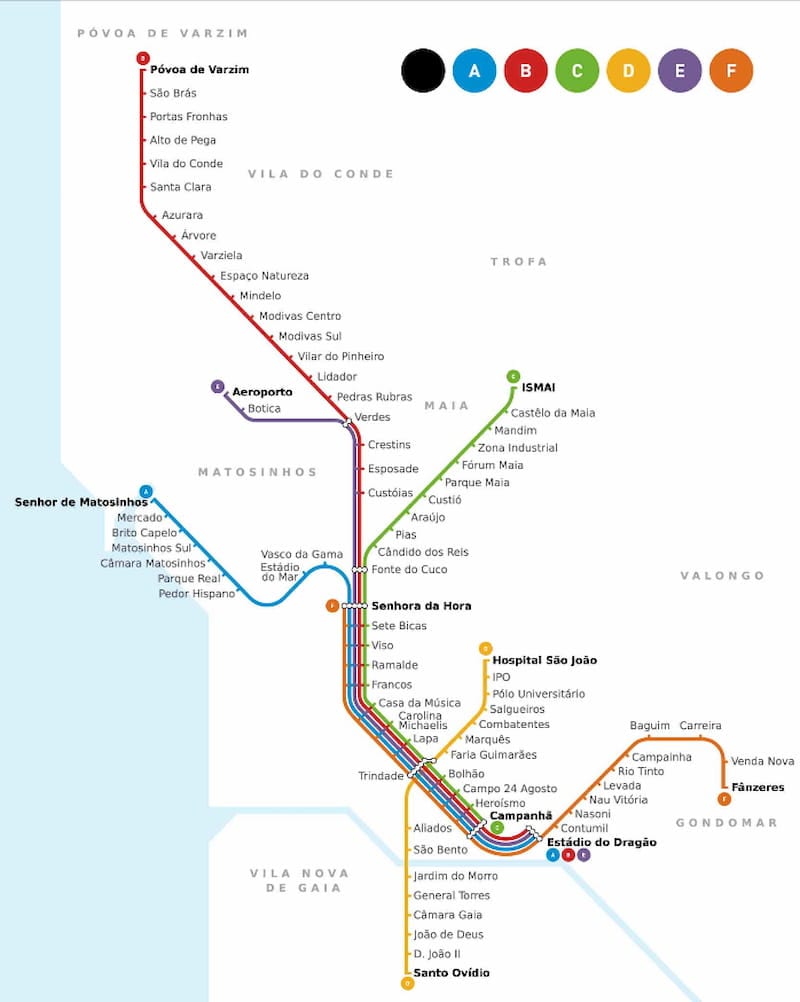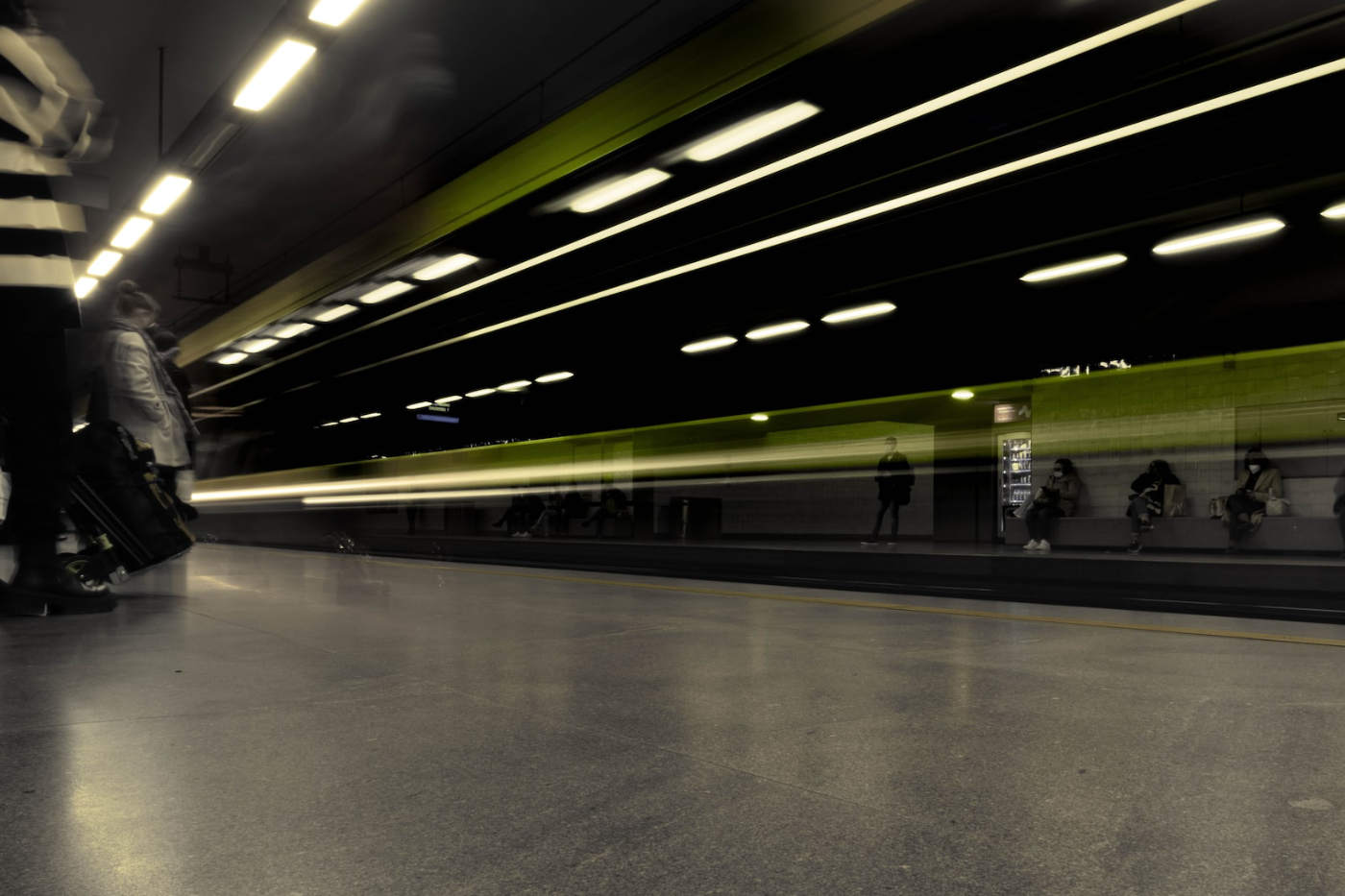The Porto Metro, also known as Metro do Porto, is one of Europe’s largest light rail networks. It operates with six lines distributed across the city, 82 stations, and 14 underground stations. The Porto Metro has been essential to the city’s public transportation system since 2002 when it first opened. It has helped to reduce traffic congestion in the city, with 12,000 fewer cars on the road and 55,000 tons fewer CO2 emissions per year. The Porto Metro transports around 9,000 people per hour, making it a popular choice for locals and tourists.
The Porto Metro operates in eight cities or municipalities, including Porto, Matosinhos, Póvoa do Varzim, Vila do Conde, Maia, Gondomar, Rio Tinto, and Vila Nova de Gaia. This makes it easy to access many attractions in and around Porto.
Porto Metro Map
The Porto Metro is divided into six lines designated by a letter or color. Here’s a quick breakdown of each line and its stations:
A / Blue Line: This line runs between the Senhor de Matosinhos and Estádio do Dragão stations, connecting the city of Matosinhos to Porto. It has a total of 23 stations.
B / Red Line: This line runs between the Póvoa do Varzim and Estádio do Dragão stations, connecting the cities of Vila do Conde and Póvoa do Varzim to Porto. It has a total of 36 stations.
C / Green Line: This line runs between the ISMAI and Campanhã stations, connecting the city of Maia (an important industrial hub) to Porto. It has a total of 24 stations.
D / Yellow Line: This line runs between the Santo Ovídio and Hospital São João stations, connecting Vila Nova de Gaia to Porto. It has a total of 16 stations.
E / Purple Line: This line runs between the Porto Airport and Trindade stations, connecting the airport to the central station of Porto. It has a total of 16 stations.
F / Orange Line: This line runs between the Senhora da Hora and Fânzeres stations, connecting Porto to Gondomar and Rio Tinto. It has a total of 24 stations.
The Porto Metro Map can be found online and displayed at all metro stations, making it easy for visitors to plan their journeys.

Porto Metro Map
How To use The Metro
To travel on the Porto metro, you must load an Andante card with the appropriate title for the number of zones your journey will cross. The zone system is similar to an onion ring, with each ring representing a zone. The further you travel across different zones, the more expensive your fare will be.
For example:
With a Z2 ticket, you can travel freely for 1 hour in the zone where you boarded, and the bordering zone rings.
If your ticket is a Z4, you can travel in two additional zone rings beyond the ring accessible with a Z2. The validity of a Z4 title is 1 hour and 15 minutes.
The Andante card is a personal card that costs €0.60 and can be charged with any title. You can purchase and charge your Andante card at all metro stations, the Tourism Information Office at the airport and S. Bento and Campanhã rail stations.
There are three types of tickets you can buy:
Andante Azul: A rechargeable paper ticket for occasional use. The price varies based on the number of zones you will travel through, ranging from Z2 (the closest and cheapest) to Z9 (the furthest and most expensive). If you buy 10 tickets at once, you get another entirely free.
Andante 24: A ticket perfect for those planning to use the metro frequently. It is valid for 24 consecutive hours after the first validation and can only be used within the zone where you first validated it.
Andante Tour: A ticket ideal for those planning to use multiple public transport options while in Porto. Depending on your chosen option, it is valid for 24 or 72 consecutive hours and can be used on the metro, STCP buses, trains, and other regional buses.
Before entering the metro platform, you must validate your ticket on the black and yellow machines. Remember that every time you change lines, you must validate your ticket again.
All Ticket Prices (2023)
Here’s a table that summarizes the different types of tickets and their prices:
Andante Azul
The Andante Azul card allows you to travel for a certain period of time, depending on the number of zones you purchase. The following table shows the prices and maximum travel times for each zone:
| Zone | Price for 1 Ticket | Price for 10+1 Tickets* | Maximum Travel Time |
|---|---|---|---|
| Z2 | €1.30 | €13.00 | 1h00m |
| Z3 | €1.70 | €17.00 | 1h00m |
| Z4 | €2.15 | €21.50 | 1h15m |
| Z5 | €2.55 | €25.50 | 1h30m |
| Z6 | €3.00 | €30.00 | 1h45m |
| Z7 | €3.45 | €34.50 | 2h00m |
| Z8 | €3.85 | €38.50 | 2h15m |
| Z9 | €4.30 | €43.00 | 2h30m |
Andante 24
The prices for Andante 24 tickets range from €4.70 (Z2) to €15.25 (Z9). The following table shows the prices for each zone:
| Zone | Price for Andante 24 Ticket |
|---|---|
| Z2 | €4.70 |
| Z3 | €6.05 |
| Z4 | €7.55 |
| Z5 | €9.05 |
| Z6 | €10.75 |
| Z7 | €12.25 |
| Z8 | €13.75 |
| Z9 | €15.25 |
Andante Tour
This ticket is ideal for those planning to use multiple public transports while in Porto. With the Andante Tour, you can visit Porto and move around the entire Andante transportation network without limits for 24 or 72 consecutive hours, depending on which option you choose. The Andante Tour prices are as follows:
- Andante Tour 1: 7.00 EUR – valid for 24 consecutive hours after the first validation
- Andante Tour 3: 15.00 EUR – valid for 72 consecutive hours after the first validation
The Andante Tour is a paper ticket and cannot be recharged.
Note: To know exactly the cost of your trip, you will need to know which zone your origin and destination are in. The furthest you travel on the Metro line and cross to a different ring (zone).
FAQ
Can I use contactless or Apple Pay?
Yes, contactless and Apple Pay are accepted on the Porto Metro. However, it is only available at some metro stations, including the Aeroporto, Casa da Música, Senhora da Hora, Trindade, Campanhã, Bolhão, Campo 24 de Agosto, São Bento, and Aliados stations.
Can I take the metro to the airport?
Yes, you can take the metro to the airport. The Porto Airport has a metro station that connects to the city’s metro network. It is located on the violet line (Linha E) and is the final stop. Check our guide about the airport of Porto for more information.
Are there lockers on the metro stations?
Yes, there are lockers available at some metro stations. They are usually located near the ticket machines, and the cost depends on the locker size. Check our article about safes in Porto for more information.
Where can I check the metro’s timetables?
You can check the metro’s timetables on the metro’s website, but it’s easier to use the metro’s journey planner or check the next arrivals on the blackboards at the nearest station. The metro operates from 6:00 am to 1:00 am, with trains running every 4 to 15 minutes, depending on the line and the time of day.
Can I park my car close to any metro station?
Yes, there are free parking lots available 24/7 near some metro stations. These are usually located outside the city center, making it easy to park your car and take the metro into the city. Check the list of them before you go.
Can I transport animals, bikes, and surf/bodyboards on the metro?
You can carry your bike, surf/body board, and baby carriage for no extra fee, but only on the first or last metro carriages. For animals, only small household pets transported inside a basket are permitted to travel on the metro unless possessing special written authorization, which is reserved for exceptional cases (i.e., guide dogs).
Conclusion
The Porto Metro is an efficient and convenient way to travel around the city. With six lines connecting eight different municipalities, the metro is one of Europe’s largest light rail networks. The metro system has 82 stations, of which 14 are underground. It transports around 9000 people per hour, reducing city traffic congestion and CO2 emissions by 55000 tons annually. The metro’s ticketing system is easy to understand, and several options are available depending on your travel needs. Contactless payment and Apple Pay are also accepted on the metro, making it easy to purchase tickets. So, if you’re visiting Porto, take advantage of the city’s metro system to explore all this beautiful city has to offer.
Photo by JOSE FERREIRA on Unsplash
